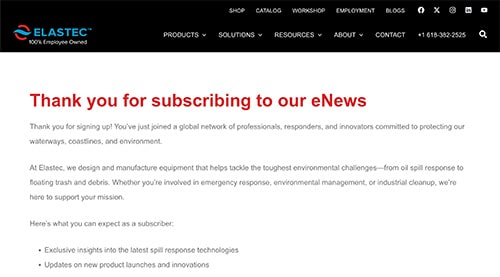What are the Main Types of Booms and Their Materials?
Oil containment booms are the frontline defense in oil spill response. These specialized floating barriers are designed to contain, control, and guide oil on the surface of water, preventing it from spreading and making recovery easier. Over the years, the field of spill response has developed several types of booms, each engineered for different environments, conditions, and response strategies. Understanding the main types of oil containment boom — and the materials that make them effective — is essential for any spill response professional.
Fence Booms
Fence booms are one of the most recognizable styles of oil containment boom. They feature a flat flotation system and a tall, flat freeboard. This design allows them to be stored compactly and deployed quickly, often from boom reels. Because of their efficiency and compact storage, fence booms like Elastec’s MaxiMax and MiniMax are commonly used for harbor and nearshore spill response.
However, the flat profile of fence booms can act like a sail in strong winds or waves, causing twisting and potential loss of containment. They are best suited for calmer waters or areas where rapid deployment and retrieval are critical.
Curtain Booms
Curtain booms feature a cylindrical flotation chamber and a continuous skirt that hangs below the surface. This design allows the boom to conform more naturally to wave action, making them more effective in rough water. Elastec’s OptiMax booms are well-known for their durability and high performance in challenging conditions.
Because of their shape, curtain booms take up more space on a reel and are generally more difficult to clean and store compared to fence booms. They are often chosen for open-water or offshore spill response where wave action is significant.
Inflatable Booms
Inflatable oil containment booms are ideal for rapid deployment in emergencies. These booms are either filled with air using a blower system or self-inflating, making them lightweight and portable. They are also easily stored on boom reels. Elastec offers a variety of inflatable booms, including models like the RubberMax or the self-inlflating ReelPak, which allows for fast, efficient deployment.
Compactible Booms
Compactible Booms are auto-inflating, have no valves and require no auxiliary equipment to be fully operational. With a compaction ratio of 5:1 this proven boom can be quickly and easily deployed in a wide variety of situations, automatically expanding to their full continuous cylindrical shape to operate and breathe at atmospheric pressure. Recovery and compaction is easy, assisted by the built-in compaction rope running the full length of the boom. Examples of this type of boom are the Barrel-O-Boom and AquaCoil.
Sorbent Booms
Sorbent booms are designed to absorb oil rather than just contain it. They look like long “sausages” made of oil-absorbent material and are deployed in conjunction with hard booms to both contain and remove oil from the water’s surface. While they lack a skirt and are not meant for long-term containment, they are a crucial part of cleanup operations.
Specialized Containment Booms
Some spill scenarios require specialized solutions. Fire booms, made with metal components and heat-resistant materials, are used for in-situ burning of oil slicks. Permanent booms are heavy-duty, fixed installations used to protect sensitive areas like ports, marinas, and power plant intakes. These solutions are designed for long-term exposure and high durability.
Materials Used in Oil Containment Booms
The performance of an oil containment boom depends heavily on its materials. Most modern booms are made from 22-ounce PVC-coated fabric, which strikes a balance between strength, flexibility, and weight. UV-stabilized PVC prevents degradation from sun exposure, extending the life of the boom.
Flotation is typically provided by closed-cell foam or air-filled chambers, while tension members and ballast chains made of galvanized steel or synthetic cables provide stability. These components ensure the boom maintains its shape and position even under wind, waves, and current.
Choosing the Right Boom
It’s important to distinguish oil containment booms from other floating barriers, such as silt curtains or debris booms. Each is engineered for a specific environmental challenge — oil containment booms for hydrocarbons, silt curtains for turbidity control, and debris booms for floating trash or vegetation. Professionals must match the right boom type and material to the conditions of their spill or project site.
Elastec’s wide range of fence, curtain, inflatable, compactible, sorbent, and specialized booms ensures that responders can find the right solution for their containment needs — whether in calm harbors, rough offshore waters, or permanent installations.
Connect With Us
Sign up for our newsletters to receive the latest news and product information from Elastec.


